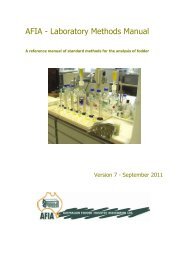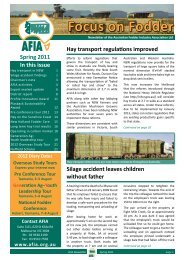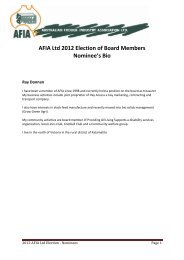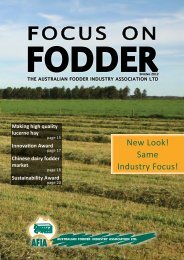NEWSLETTER - Australian Fodder Industry Association
NEWSLETTER - Australian Fodder Industry Association
NEWSLETTER - Australian Fodder Industry Association
Create successful ePaper yourself
Turn your PDF publications into a flip-book with our unique Google optimized e-Paper software.
From Charlie Williams Jenharwill Baling<br />
Elmore Vic.<br />
I would like to thank all who participated in<br />
the tours and conference in Darwin. The<br />
positive feedback has been very good, and it<br />
has greatly strengthened AFIA’s standing as<br />
a “truly <strong>Australian</strong>” organization. I am sure<br />
many of you will venture back in the near<br />
future. Thanks to Anne and Colin for their<br />
organization and planning, and to all who<br />
had enough faith to have a go.<br />
Dan Halloran, of Northern Ag had a very<br />
positive input, and I am sure he will be justly<br />
pleased with the result. The many sponsors<br />
who participated can surely see the benefit<br />
from being part of the organization, and I<br />
thank them and encourage them to continue<br />
to support us.<br />
The top end tours were a fabulous success,<br />
with many looking forward to perhaps the<br />
same again next year. It was great to see so<br />
many couples enjoying the mix of<br />
agriculture, tourism and networking, and a<br />
great pleasure to be with such a happy group.<br />
I thank the territory Government (DPIFM)<br />
for their financial support, but cannot help<br />
but think of the missed opportunity by the<br />
The following provides a snap shot of recent<br />
activities of the AFIA.<br />
Chemical residues in hay<br />
AFIA and export members have been busy<br />
addressing the new laws regarding residues<br />
on imported feeds into Japan. Maximum<br />
residue limits (MRLs) now are in place for<br />
imported feeds including hay and all growers<br />
of export hay and straw need to be mindful<br />
of the sensitivities the Japanese have to<br />
certain chemicals.<br />
Due to the differences of MRLs between<br />
Chairman’s Notes<br />
minister to<br />
mix with the<br />
very best of<br />
Australia’s<br />
fodder<br />
producers<br />
and<br />
exporters,<br />
with regard<br />
to promoting<br />
agriculture in<br />
the territory.<br />
AFIA Activities<br />
Once again the season is on the brink, with<br />
most areas desperate for rain. I can only<br />
hope that by the time you read this the<br />
heavens have opened a little, and we can<br />
once again scrape through.<br />
The great success of the conference must not<br />
blind us to the tasks in hand, as it is our<br />
obligation, and indeed vital to our industry<br />
that we focus on our major priorities, that is<br />
transport, levy and IPP. We will be diligent<br />
in our efforts to sign off on these projects as<br />
soon as possible.<br />
I wish the new committee all the best and<br />
thank you all for your support.<br />
Australia and Japan, it has been identified<br />
that desiccants present a risk of breeching<br />
Japanese limits. Export hay crops should not<br />
be sprayed with these chemicals late in the<br />
season.<br />
Due to an environmental problem with<br />
vegetable production in Japan, export hay<br />
and straw growers need to be aware of limits<br />
placed on the use of clopyralid used in<br />
Lontrel, Growers are advised to contact their<br />
export hay processor for further details of<br />
limits placed on all chemical treatments.<br />
AFIA Newsletter September 2







